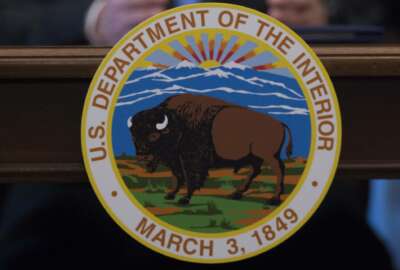 Exclusive
Exclusive For the first time, Interior makes more details of recent SES reassignments public
According to new documents from the Interior Department, 33 senior executives received reassignment notifications back in June. Of the 33, 10 received requests ...
Subscribe to Federal Drive’s daily audio interviews on iTunes or PodcastOne.
The Interior Department is beginning to make more details public about its recent — and often controversial — round of senior executive reassignments.
Thirty-three senior executives, or 15 percent of the department’s Senior Executive Service cadre, received reassignment notices from Interior on June 15. Twenty-three of those SES accepted and made the transfer to their new positions, according to documents Interior recently made available.
It’s the first time the Interior Department has publicly stated the number of executives involved in its June round of reassignments. Members of Congress and senior executives involved in the Interior reassignments had provided rough estimates of the total number, but the exact number was unknown.
The release from Interior comes a few weeks after Joel Clement, a former senior executive who publicly resigned after the agency reassigned him, sued the department. At the time, Interior hadn’t complied with any of Clement’s roughly 30 Freedom of Information Act (FOIA) requests for documents related to the department’s decision to reassign one-third of its SES members.
Interior will make more information available on a rolling basis, according to a Dec. 4 letter Clement received from the department’s FOIA office.
The department posted 4 batches of documents on its online FOIA library. Among those documents is a list of every senior executive who received a reassignment, memos from the department’s Executive Resource Board (ERB) approving the rotations, notification memos each of the SES members received in June and a list of SES arrivals and departures to each Interior bureau.
At least 10 executives were asked to relocate geographically, and six of them accepted and made the move, according to Interior documents.
The former Alaska state director for the Bureau of Land Management made the move from Anchorage to Washington to be a senior energy adviser for the U.S. Fish and Wildlife Service, according to Interior documents.
One executive accepted a geographic reassignment, but reconsidered, and decided to retire at the end of the year.
Another executive, who performed her work in Louisiana, but received a geographic reassignment to Washington, D.C., voluntarily downgraded to a GS-15 ecologist position.
In some cases, Interior appeared to make special accommodations after consulting with the SES members. One executive, for example, accepted his reassignment and asked that he continue to do the work of his new position in Albuquerque, New Mexico, for the first nine months before moving to Washington.
In others, Interior made the decision not to move forward with the reassignment. In one proposed transfer that involved four different positions, neither of the executives moved to the jobs the department originally proposed. One of the executives instead asked for a new transfer.
“All laws and regulations regarding SES reassignments were followed,” Mary Pletcher, Interior deputy assistant secretary for human capital and diversity and chief human capital officer, wrote in a Dec 4. letter to members of Congress. “As the department’s chief human capital officer, I, along with the deputy solicitor for general law (both career members of the SES), reviewed all reassignments to ensure that SES members were being reassigned properly. To ensure equitable treatment, I emailed the proposed or formal notice of reassignment to the impacted SES members.”
Clement, who said he was reassigned in retaliation for his statements about climate change, also filed a whistleblower complaint with the Office of Special Counsel. He resigned in October, citing poor leadership as one of the reasons for his departure.
Though Clement acknowledged Interior’s initial document release is a start, he and his lawyer, Katie Atkinson, said it barely scratches the surface of their original requests. In particular, they’re looking for more details on the department’s rationale for his reassignment.
In addition, Interior hasn’t told Atkinson about the documents it plans to release in the future or what information it doesn’t plan to provide. For now, Atkinson said she’ll check Interior’s FOIA website for more documents.
“The frustration is that if [Interior had] done things by the book, they’d be more forthcoming,” Clement said. “Their lack of transparency is pretty damning.”
Clement played a key role in the department’s response to climate change as the former director of the Office of Policy Analysis. He worked specifically with coastal Alaskan communities to prepare them for impacts of major weather events. His reassignment, however, brought him to the Interior Office of Natural Resources, where he was expected to do audit work, of which he has no experience.
“As the director of the Office of Policy Analysis, you oversee the development of the annual report on the department’s economic contributions to the national economy,” James Cason, chairman of Interior’s Executive Resources Board and associate deputy secretary, wrote in a June 15 memo to Clement informing him of his reassignment. “You are experienced at leading experts that provide objective economic and policy analysis. You are well qualified to serve as senior program adviser of the Office of Natural Resources Revenue.”
According to Clement, the department’s rationale is a bit of a stretch.
“It’s certainly true that I managed economists, but we were working on policy issues that were far removed from the Office of Natural Resources Revenue,” he said.
Deputy Interior Secretary David Bernhardt wrote to every member of the department’s SES cadre last week, explaining his vision for the Senior Executive Service. Reassignments, he said, will continue to play a role in the department’s push to improve collaboration.
“Going forward, I will seek to strike a balance between leadership continuity and achieving fresh perspective by reassigning SES employees across bureaus and offices,” Bernhardt wrote.
Clement’s reassignment memo is similar to the letters the 32 other reassigned executives received in June. Each of the notification letters describes the executive’s current position, the duties of the career leader’s new position and a brief explanation for the reassignment.
In some cases, the reassignments appear to be lateral moves.
For example, the department moved the Washington, D.C. director of the Office of Law Enforcement and Security at the Bureau of Land Management to be the new chief of the U.S. Fish and Wildlife’s Office of Law Enforcement.
“You are well qualified to lead the U.S. Fish and Wildlife Service’s agents, wildlife inspectors, officers and other law enforcement personnel as the Chief of the Office of Law Enforcement,” the executive’s notification memo reads.
Interior’s director of acquisition and property management also received a reassignment notice. The department wanted to place the executive as the Bureau of Land Management’s assistant director for business, fiscal and information resources management. The executive chose to retire, according to Interior documents.
The Interior Department did not immediately respond to requests for comment about the release of reassignment documents.
Copyright © 2024 Federal News Network. All rights reserved. This website is not intended for users located within the European Economic Area.
Nicole Ogrysko is a reporter for Federal News Network focusing on the federal workforce and federal pay and benefits.
Follow @nogryskoWFED






